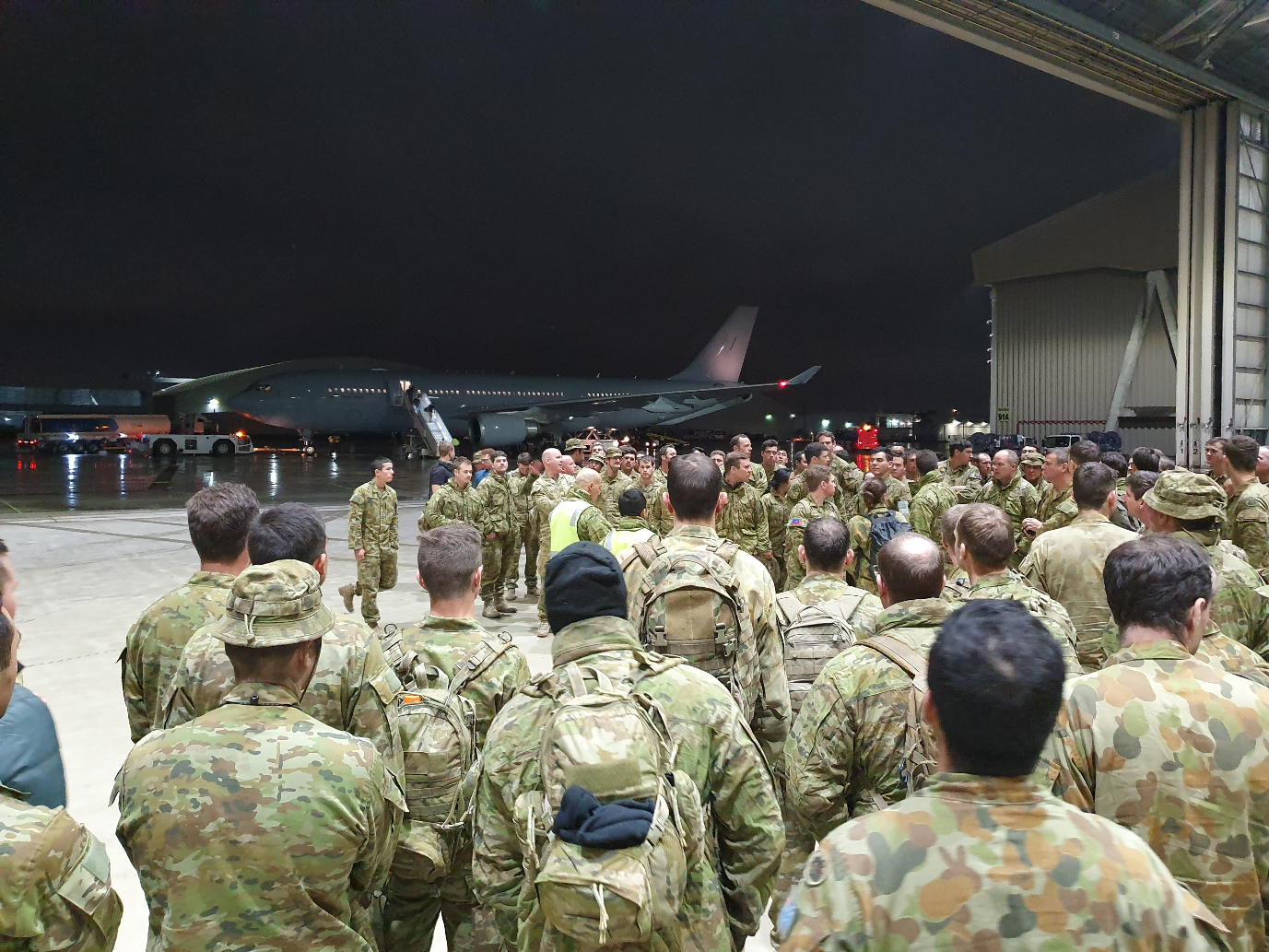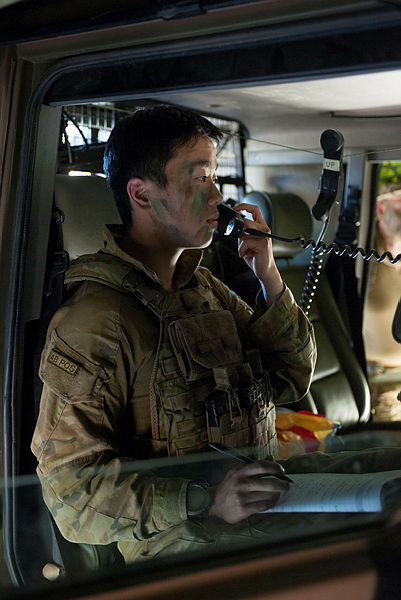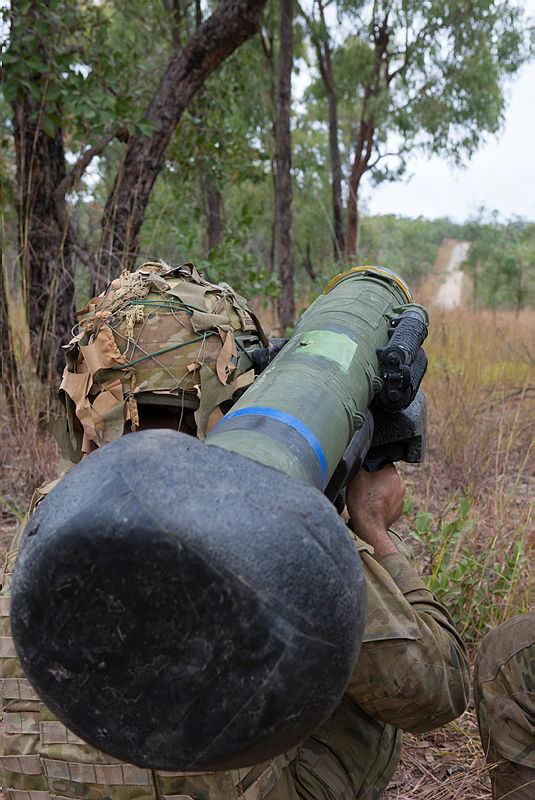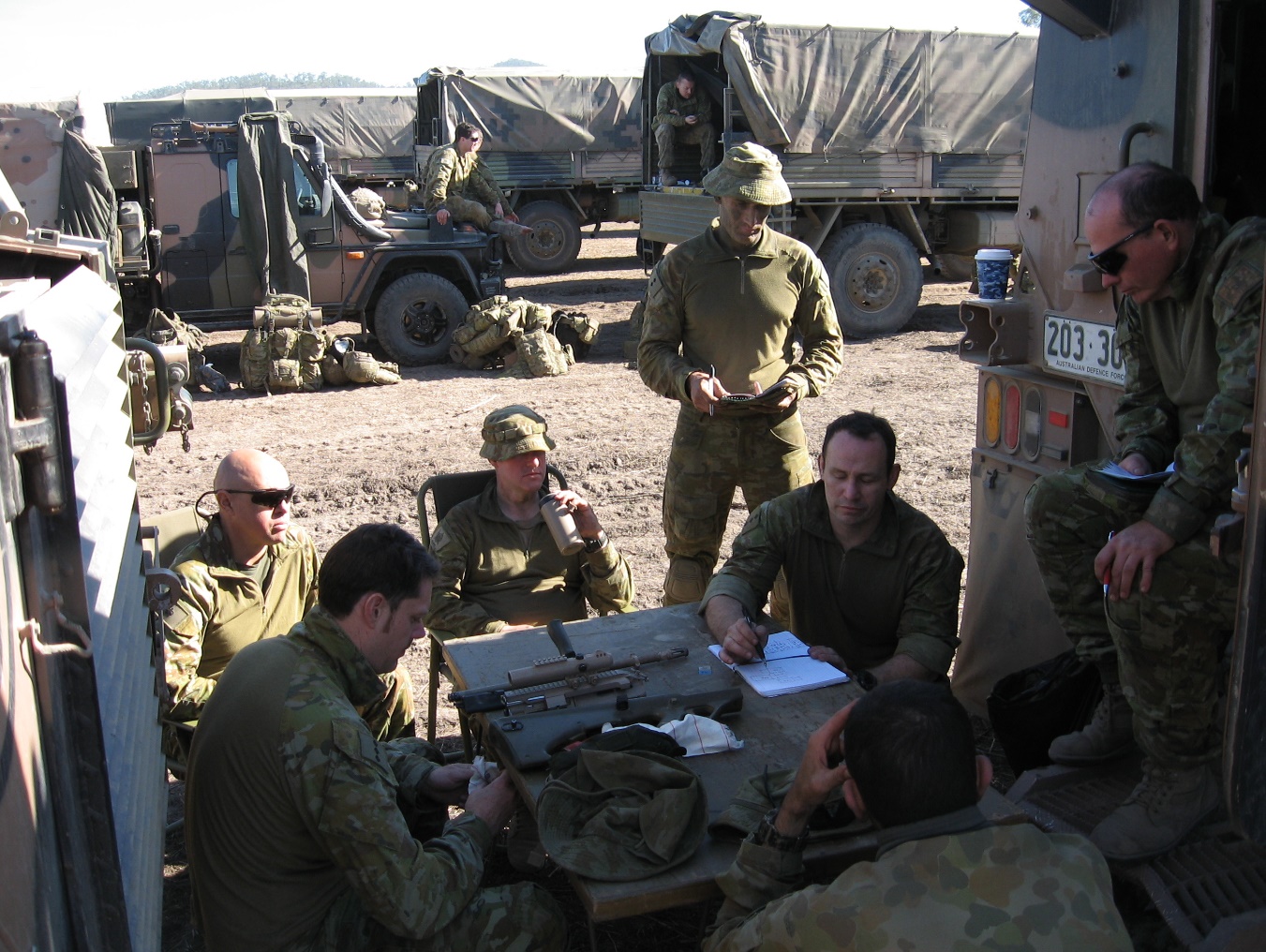Background
In July 2019, the 4th and 9th Brigades generated their Reinforcing Battle Group (RBG), known as BG Jacka, in support of the 1st Brigade for Exercise Talisman Sabre 19 (Ex TS19). Extensive lead up training enabled BG Jacka to successfully deploy and conduct a wide range of tasks, including integration with Task Group Wolfhound from the US 25th Infantry Division for air mobile operations, and providing an entire Combat Team to BG Boar. We also had Cavalry Scouts, Cooks and Engineers detached to their paired 1st Brigade units, enhancing those units’ capabilities. There were, however, significant opportunities for improvement with the preparation, employment and extraction of the BG.
This paper attempts to highlight the opportunities for improvement based on the experiences of BG Jacka, particularly in the BG Headquarters, to enable our sister reserve brigades train, deploy, fight and refit with their paired regular Army brigades more efficiently and to improve the combat power the RBG can generate.
Training
Within the Force Generation Cycle, the reset year is dedicated to individual skills. A key skills deficit within the two brigades was qualified drivers. This impacted the move of vehicles to the mounting base at Rockhampton, the insertion to the Shoalwater Bay Training Area (SWBTA) and movement within our Area of Operations (AO). Planning was unduly impacted by the need to identify individual drivers on some occasions because of the paucity of those key skills within the BG. The movement of vehicles to SWBTA was a considerable task and required a large number of drivers, which placed a strain on the ability of the 4th and 9th Brigades to generate the RBG. A focus on ensuring more drivers are trained for the vehicles that will be employed will pay significant dividends for the next rotation.
Given the high level of IT and Comms integration now required, a wide and diverse range of skills are required from our Signallers. It was apparent during the lead up exercises and on TS that a mix of skillsets from the supporting Signals units is critical. Whilst we often were well supplied with Signallers for voice comms, there were often insufficient signallers with experience in establishing and supporting our digital Battle Management Systems. Ensuring we have enough Signallers with technical experience and expertise is also critical to ensure that Comms is a C2 enabler, not an inhibitor.
Deployment
One of the recurrent After Action Review points with the RBGs is that they deploy into the field before they are ready. This occurred again with BG Jacka. In fact, BG Main HQ deployed into the field before one of our Combat Teams had even landed at Rockhampton. Rather than this being an issue, I believe that the question needs to be framed as to how we deploy into the field in a better state – ready to fight, accepting that minimal time is available for RSO&I. Standard expectations should be set around what individuals soldiers are to bring on exercise. There were wide variances in what equipment soldiers actually bought, including personal equipment, weapons and consumables. If an euipment start state is agreed to, and soldiers adhere to it, the RSO&I process will be significantly smoother.
The procurement and transport of Controlled Cryptographic Items (CCI) and Comms equipment presents specific challenges; the management of the transportation and preparation of comms equip requires a significant amount of planning to ensure a smooth deployment into the AO.
A clear equipment list, with responsibilities for provision, and a clear scheme of manoeuvre for transporting that equipment is important. Flexibility is a key principle in the generation of the RBG, acknowledging that you never know who will attend until they actual move into the AO. However, for non-personal equipment, much of this can be predicted and a master document with clear responsibilities for provision and transportation of BG equipment would significant speed up insertion into the AO. It would also decrease the likelihood of elements arriving at Rockhampton with no equipment and expecting to be supplied when they were meant to be deploying with that equipment.

Personnel
Despite a large effort being made to have the same personnel in the same positions across Exercises Jacka Crawl, Jacka Walk, Jacka Run and Talisman Sabre, we still had a number of roles that were performed by people for the first time. Because of this, laminated Job cards should be created for each of the key positions within the BG HQ. These would detail the roles and responsibilities and their part in the battle rhythm within the HQ to ensure that key personnel stepping into a new role can commence that role understanding what is required. The training series was well conducted and ensured that a core of BG HQ staff were very familiar with the requirements within the BG HQ and this added in the smooth running of the HQ. The lead up training also facilitated the ability of the BG HQ to function as a team.
We deployed with a great team, but with little depth. A number of key personnel, including the Battlegroup's Commanding Officer, were medivaced during the exercise. It emphasised the importance of training for one up, as well as the importance of the implied task in the duty statements for individuals to understudy their commanders – the implication that the person may actually need to step up to that role was repeatedly played out for real on the exercise. These occasions were met with everyone leaning forward into their news roles and responsibilities, and the BG was able to function with minimal disruption, however some minor changes in the way these roles are trained and exercised should make for smoother transitions in the future.
Communications
Communications were a significant problem within the BG. Robust liaison needs to be conducted with the partnered brigades to understand the start state that the Combat Signals Regiment is looking for from the BG so that we can move elements through the theatre gateway as quickly and efficiently as possible without creating a disproportionate amount of work to ensure effective communications.
 The PACE (Primary, Alternate, Contingency and Emergency) Plan needs to be resourced appropriately. Whether due to atmospheric conductions, physical terrain or enemy action, our primary comms often did not work. The reliance on voice comms created a bottleneck as it was expected that much of the communication would be digital; however when we fell back to voice comms, we found we did not have enough capacity for comms. On exercise it is of paramount importance to maintain comms to ensure a viable Casevac plan can be enacted as a bare minimum. On operations, it is imperative for the maintenance of Command and Control and to support a faster decision making cycle. The PACE plan is designed to provide robust comms and its importance requires that it be resourced, with personnel and equipment, appropriately. From a C2 point of view, there potentially needs to be a better use of Mission Command to enable rapid action in a Comms degraded environment. The BGHQ could also have been well served with more satellite phones and the means to keep them charged 24/7.
The PACE (Primary, Alternate, Contingency and Emergency) Plan needs to be resourced appropriately. Whether due to atmospheric conductions, physical terrain or enemy action, our primary comms often did not work. The reliance on voice comms created a bottleneck as it was expected that much of the communication would be digital; however when we fell back to voice comms, we found we did not have enough capacity for comms. On exercise it is of paramount importance to maintain comms to ensure a viable Casevac plan can be enacted as a bare minimum. On operations, it is imperative for the maintenance of Command and Control and to support a faster decision making cycle. The PACE plan is designed to provide robust comms and its importance requires that it be resourced, with personnel and equipment, appropriately. From a C2 point of view, there potentially needs to be a better use of Mission Command to enable rapid action in a Comms degraded environment. The BGHQ could also have been well served with more satellite phones and the means to keep them charged 24/7.
One workaround that was effected was the use of a field telephone. Whilst limited due to the requirement for wire to be run, it managed thousands of calls and was the primary source of Comms between the BGHQ and the Combat Service Support Team providing logistics support.
A number of BGHQ pers attended the 1st Brigade Headquarter's Op Sync Conference when possible. This was of great value, allowing for not only a much better understanding of how the battle was progressing but also informal liaison and planning. This went a long way to remediating some of the comms issues between brigade and the battlegroups.
The use of Liaison Officers with flanking units was useful, but they require Comms with their parent unit to be truly effective.
Within the Exercise
BG Jacka detached a number of elements to other call signs during the exercise and elements were cut to us periodically as well. At times the command relationship was hazy to say the least and both detached elements and HQs need to be clear about Command Status to ensure proper C2 is affected.
Within the Command Post (CP)
The BG CP was unnecessarily noisy: there were more people in the brigade CP with much less noise. CP discipline and procedures need to be reinforced. There is a natural tendency for members to want to ‘drop in’ and see what is happening, but this degrades the CP staff’s ability to work and needs to be aggressively discouraged.
The Comms frustrations saw members engage directly with signallers in an effort to get messages sent. This is the incorrect procedure; all messages needing to go through Watchkeepers to facilitate their maintenance of situational awareness.
The BG's play books were only used intermittently and this was detrimental to the CP's performance. The drilling into all CP members of the importance of the playbooks is critical.
There were no squawk boxes in the CP, which degraded the situational awareness of the Watchkeepers and the Battle Captain. The lack of squawk box would not have been an issue had there not been so much voice comms, but the nature of the environment required a lot more voice traffic than expected.
The battle rhythm needs to be adhered to ensure all team members receive adequate sleep. As the BG HQ lost key personnel, some of the team started to work longer hours and the perennial struggle of picquets, work and rest balance meant that some members ended up working hours that were not sustainable.
The list of Commander's Critical Information Requirements (CCIR) needs to be clearly identified at the start of the exercise. The CCIR list should include the reason for them and actions on, enabling faster information flow and decision making to support the BG Commanding Officer.
Warrior Culture
The role of the BG HQ is to provide C2 to the Commander, but at it is important to remember that even when providing support to Rear Area Security Operations taskings, the enemy dictates that where the front line is drawn and therefore all members must be vigilant and disciplined. Given the short time available ‘in the box’ this needs to be worked on from Day 1.
Rehearsals
Rehearsals of some of the key activities, particularly around local area defence are critical. We rehearsed our Casevac procedures and these were done very early in the exercise, enabling generally smooth No Duff casevacs, but other types of rehearsals should also have been conducted. Rehearsals and clear 'actions on' would have assisted in creating a more aggressive reaction when the headquarters was in contact.
Equipment
 Numerous Talisman Sabre and Hamel exercises have highlighted the ability of high value targets within the rear area to attract enemy reconnaissance and armour. The primary role of the RBG is to secure the rear area and Mission Analysis should highlight the likelihood of conducting anti-armoured tasks. The provision of the RBG with a more effective anti-armour capability than the 84 mm Carl Gustav would enable the RBG to create dilemmas for enemy commanders about how they will achieve the objectives of their raids. Having an RBG Combat Team attempt to protect a logistics node that has better defensive equipment than the Combat Team protecting it limits its effectiveness the defensive role.
Numerous Talisman Sabre and Hamel exercises have highlighted the ability of high value targets within the rear area to attract enemy reconnaissance and armour. The primary role of the RBG is to secure the rear area and Mission Analysis should highlight the likelihood of conducting anti-armoured tasks. The provision of the RBG with a more effective anti-armour capability than the 84 mm Carl Gustav would enable the RBG to create dilemmas for enemy commanders about how they will achieve the objectives of their raids. Having an RBG Combat Team attempt to protect a logistics node that has better defensive equipment than the Combat Team protecting it limits its effectiveness the defensive role.
On one occasion, a platoon from the RBG found itself at close range to numerous enemy armoured vehicles conducting a temporary halt, but without anti-armour weapons they were unable to engage the targets.
The provision of effective anti-armoured weapons can dramatically increase the effectiveness of dismounted infantry against a mounted enemy.
After Action Review (AAR)
On occasion, there was insufficient time for AARs to be conducted across all of the levels required. There is a lot to be gained from a BG HQ conducting an AAR with both BG HQ staff and sub-unit commanders to fully understand how the battle was conducted and to discover lessons learnt and/or put remediation measures in place when required. When this was able to happen, it produced significant benefits.

Exfil
The FIET (Force Infil / Exfil Team) needs to be appropriately resourced to be able to manage the smooth move of the BG into the AO as well as its extraction and subsequent return to its home location. The difficulty of their job was compounded by the lack of a centralised source of information for the logistics and movement plan and lack of comms with the BG. The creation of a single master document with the movement plan for all personnel and all equipment would greatly assist in the management of the Reverse RSO&I process. This, along with extraction planning starting before the insertion, would ensure a smoother extraction.
Conclusion
Despite the issues listed above, BG Jacka, the 1st Brigade headquarters and the other BGs worked well together, relying heavily on flexibility to overcome self-imposed, incidental and enemy inflicted friction. Many of the soldiers in the Combat Teams were involved in excellent training opportunities and the BG's sub-units were able to effectively contribute to the brigade's scheme of manoeuvre. By looking at some of the lessons learnt during Ex TS19, we can look to improve the training, deployment and force generated by BGs Jacka, Cannan and Waratah in the future.










"The present bush fire scenario has underscored the importance of comprehensive co-ordination and oversight. The scale and disparate nature of requirements are immense, from pre-positioned generators, to well-located and resourced evacuation centres, to traffic management plans, to availability of effective face masks etc. There are many lessons to be learnt from the current situation and responses to it. I heard one account on the radio of an evacuation centre located at the top of a flight of twenty-five steps. There was a lift, but the power was out, hence those who were disabled could not gain access. The lessons here are obvious. But how is Emergency Management Australia ‘harvesting’ them? The traditional approach is to wait until the ‘crisis’ is over and then prepare a report.
This is pretty much the way the Australian Army operated in Vietnam. To be truly effective, however, such operational analysis must occur in real time, with feedback enabling failures to be immediately corrected and successes reinforced. While it is essential that a detailed report inform subsequent contingency plans, so too must there be feedback and continual improvement as things are actually happening."